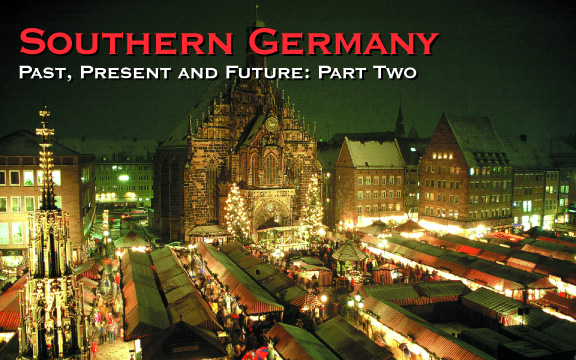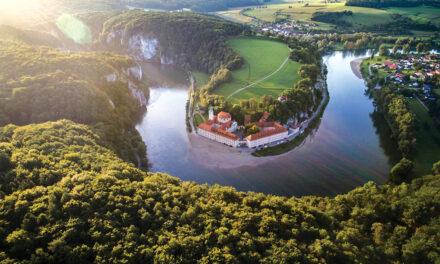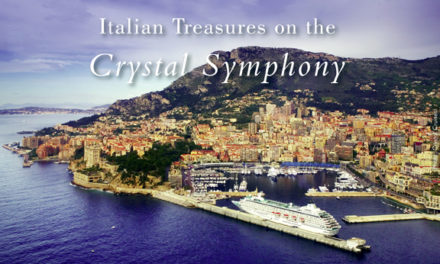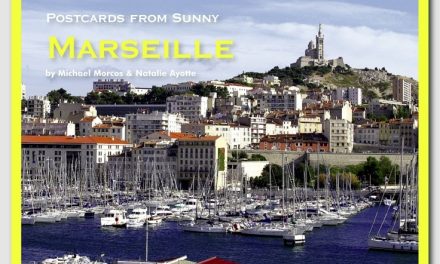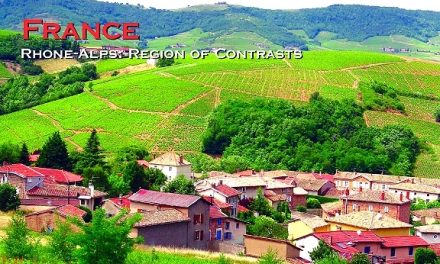Southern Germany
Past, Present and Future: Part Two
Published in the Fall 2007 Issue of Canadian World Traveller
By Greg James
Photo Credits:
German National Tourist Office (www.cometogermany.com)
Munich Tourism Office (www.muenchen.de)
Nuremberg Convention and Tourism Office (www.tourismus.nuernberg.de)
In Part One of our fascinating weeklong Arts and Culture Tour of Southern Germany, we visited the university town of Heidelberg, the UNESCO World Heritage Site of Maulbronn Abbey and the vibrant City of Stuttgart, capital of the southwestern state of Baden-Württemberg and home to world-renowned car manufacturer Mercedes-Benz.
In this instalment, we travel eastward along Germany’s super-fast autobahns to explore the ch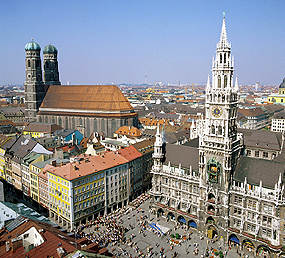 arming Danube River town of Ulm, which was the birthplace of Albert Einstein. The town is actually located in Baden-Württemberg, but its twin town Neu-Ulm lies across the river in neighbouring Bavaria.
arming Danube River town of Ulm, which was the birthplace of Albert Einstein. The town is actually located in Baden-Württemberg, but its twin town Neu-Ulm lies across the river in neighbouring Bavaria.
Our tour then takes us to Munich, the capital city of Bavaria, famous for its annual Oktoberfest, and host city of the 1972 Olympic Games.
Last but not least, we discover the City of Nuremberg, which has so much more to offer its visitors than its notoriety as the site of infamous events during the era of the Third Reich.
Unique Twin Towns
We disembarked from our minivan at the edge of Ulm, which together with its twin town counts some 170,000 residents. We were greeted by our affable local guide, who was rather distinguished looking and though being of a certain age, was quite spry. He quickly led us down Ulm’s wide pedestrian shopping street.
The street was filled with locals and visitors enjoying a stroll in the warm afternoon sun. We were on our way to the town’s main square to visit its famous Münster, but stopped briefly at the spot where Einstein was born back in 1876. The house no longer exists, but cobblestones trace out its footprint.
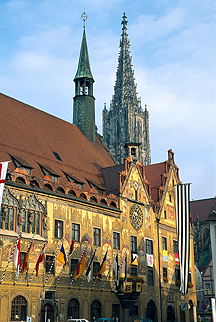 World’s Tallest Spire
World’s Tallest Spire
The Ulm Münster, which became a Lutheran church during the Reformation, is the second largest Gothic church in Germany after Cologne’s cathedral, but Ulm rightly claims to possess the tallest church spire in the world!
We had to crane our necks backward to take in its 161 metres, while those of us with cameras attempted to snap the entire soaring spire in one frame.
The interior of the centuries-old church was equally impressive. But its most astonishing feature was a modern stained-glass window, prominently positioned above one of its main exits. It depicted the history of the Jewish people and was commissioned by the citizens of Ulm in recognition of the injustices visited on its local Jewish community during the Nazi regime.
Ulm Promenade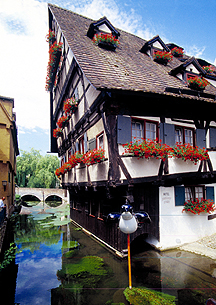
Our short visit to Ulm included a walk on the bank of the Danube alongside the 500-year-old wall that once protected the town.
We continued our stroll through the charming alleyways and over the picturesque canal bridges of the Fishermen’s and Tanners’ Districts, which are lined with individually decorated historic half-timbered buildings.
We reluctantly said goodbye to our gracious hosts at the Ulm Museum over coffee and freshly baked pretzels.
This fascinating museum features everything from prehistoric artefacts found in the area to modern art by the likes of Warhol and Picasso. I only wish we had the time to fully explore all of its excellent galleries.
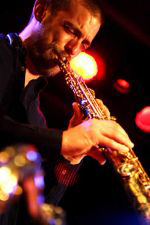 Munich & All That Jazz
Munich & All That Jazz
To try to describe all of the attractions offered by this Bavarian capital city of over one and a quarter million inhabitants would not only be difficult, but futile. Therefore, I will try to cover just a few highlights of our whirlwind two-day stay.
We took the city’s efficient underground system from the Arabella Sheraton Grand Hotel to the Unterfahrt Jazz Club in downtown Munich. What a treat there was in store for us! The atmosphere was like that of an early North American jazz club, but the menu was definitely Bavarian, offering lots of tasty sausage dishes and a wide choice of local beers and wines.
On the night we were there, the Dusko Goykovich Big Band was playing, with over twenty of its talented musicians and a baby grand piano squeezed onto the tiny stage. Who would have imagined that Munich was such a hotbed of jazz!
The City by Day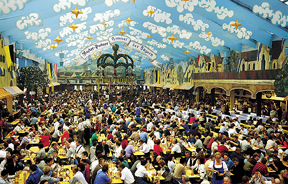
The following morning, we were on a tour of the city by minivan. Our guide Vicky gave us a running and often amusing commentary on the historic and modern structures of Munich and its legendary Oktoberfest, which annually attracts droves of international tourists to the city.
We learnt from her that, in typically German practicality, the fest even provides a special tent where revellers who can’t make it home can spend the night in relative comfort and security.
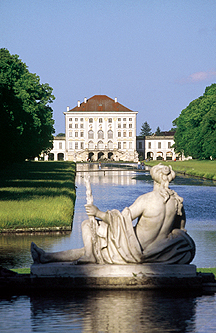 Nymphenburg Palace
Nymphenburg Palace
Part of our city tour included the baroque Nymphenburg Palace and its extensive park, located in the western part of Munich.
The construction of the palace began in 1664. It was built as a summer residence for the Bavarian princes and features ornately decorated rooms and lush garden landscaping with impressive outdoor statuary and fountains. One could spend an entire day here!
Lunch at Marienplatz
We ended our city tour at the historic Ratskeller Restaurant of Munich’s Rathaus or City Hall, which is located on Marienplatz.
It was May Day, a national holiday in Germany, and the picturesque square was even more animated than usual, as it was the site of a daylong open-air concert. As we would find on the entire trip, the local fare offered at the Ratskeller Restaurant was absolutely delectable!
History, Art & Cuisine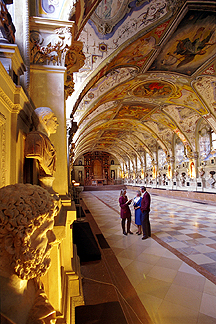
After our scrumptious lunch, we visited the Residenz Palace of the Wittelsbach dynasty, which served as the seat of government and residence of the Bavarian dukes, electors and kings from 1508 to 1918.
The wings and annexes of the palace, located in the heart of Munich’s Old Town, have been lovingly restored and are a dream come true for aficionados of the Rococo style of architecture.
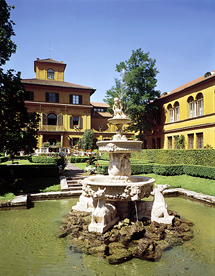 Blue Riders
Blue Riders
We leapt into more recent times on our next visit to the Lenbachhaus Gallery, housed in a Florentine-styled building.
The gallery is famous for its the large collection of paintings of Der Blaue Reiter (The Blue Rider), a group of expressionist artists established in Munich in 1911, which included among others Wassily Kandinsky, Gabriele Münter, Franz Marc, August Macke, Marianne von Werefkin, and Paul Klee.
That evening, we dined at the Spatenhaus Restaurant where I had the best Wiener Snitzel I have ever eaten. The prices are reasonable and the portions of the restaurant’s typical Bavarian dishes are more than generous! The next morning, we headed for Nuremberg, perhaps the most surprising destination of the entire trip.
Fascinating Nuremberg
We arrived at Nuremberg’s Centre of Documentation and were met by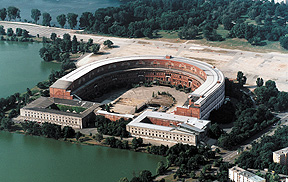 our local guide, Thomas. The centre is the city’s way of acknowledging the role it played as the site of the infamous Nazi Party Rallies in the 1930’s.
our local guide, Thomas. The centre is the city’s way of acknowledging the role it played as the site of the infamous Nazi Party Rallies in the 1930’s.
Thomas explained that, until his generation, many Germans had a difficult time talking about that dark chapter in their country’s history. This was particularly true for residents of Nuremberg, which was proclaimed a symbol of National Socialism.
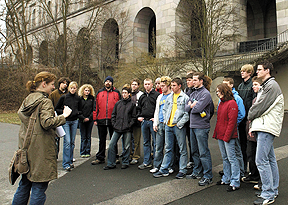 Our tour included the parade grounds and the ruins of the structures used for the rallies.
Our tour included the parade grounds and the ruins of the structures used for the rallies.
Educational tours for local schoolchildren are an important part of the centre’s role in ensuring that “never again” remains a reality for generations to come.
However, for first-time visitors to Nuremberg, there are many other fascinating aspects of this vibrant historic city of half a million residents to explore and enjoy.
Handwerkerhof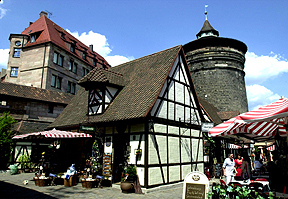
After checking into the Arabella Sheraton Hotel Carlton, we took a pleasant stroll to Handwerkerhof. This “Crafts Yard” is located right in the middle of the city, close to Nuremberg’s main train station.
Surrounded by the towers and walls that were part of the city’s medieval fortifications, Handwerkerhof offers the visitor a chance to see traditional craftsmen, such as pewterers, glass engravers, potters, gold and silversmiths, gingerbread bakers and doll makers as they work. Their workshops are located in the charming half-timbered houses that line Handwerkerhof’s winding lanes.
After browsing through a few of the workshops, we stopped for lunch at the Bratwurstglocklein Restaurant and had Nuremberg’s famous roasted sausages, fresh white asparagus salad and tankards of chilled Nuremberg beer. Thus fortified, it was time to visit the Imperial Castle.
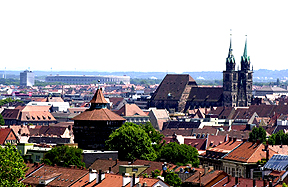 A Medieval City
A Medieval City
The history of Nuremberg dates back to 1050, when the Staufer Emperors extended the Castle, which stood on the city’s prominent sandstone hill, and turned it into an imperial palace.
During the Middle Ages, Nuremberg was an important centre of trade and became very wealthy.
Our well-informed and enthusiastic guide gave us a tour of the castle, after making sure we had all survived the energetic but worthwhile climb to the top of the rather steep hill.
On our way down from the Castle, we made a brief visit to Albrecht Dürer’s House, which showcases the living and working quarters of the great artist. A tour takes visitors through all four storeys of this house, which was Dürer’s residence between 1509 and 1528.
Auf Wiedersehen to Nuremberg
After saying goodbye to our intrepid guide Thomas over coffee at one of Nuremberg’s many sidewalk cafés, we made our way back to the hotel along one of the most charming pedestrian shopping streets I have ever strolled. Several of the city’s beautiful historic churches grace the street and its cobble-stoned squares.
That evening, we had the last dinner of our trip at the Schwarzer Bauer, a traditional Nuremberg brewing pub. Before we ate the hearty meal, the proprietor took us on a brief tour of the brewing facilities and down the four levels of caves where the beer was stored before the invention of modern refrigeration. In olden days, these caves were craved out of the soft sandstone hill that gave Nuremberg its name. The original spelling “Norenberc” meant “rocky hill”.
Nuremberg’s Christkindlesmarkt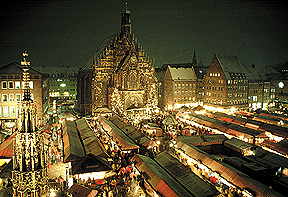
Every year, Germany’s most famous Christmas Market opens its stalls to visitors from all over the world on Nuremberg’s Main Market Square. By Christmas Eve of each year, more than two million visitors would have sampled the delights of the Nuremberg Christmas Market.
Over 200 open-air stalls offer traditional wares such as Nuremberg’s famous spicy gingerbread and typical Christmas articles such as Christmas tree angels, cribs, Christmas tree ornaments, candles, and toys, as well as arts and crafts. Local food and drink are also part of the festivities.
With any luck, I will find myself back in Nuremberg between November 30th and December 24th to enjoy this unique Yuletide celebration!
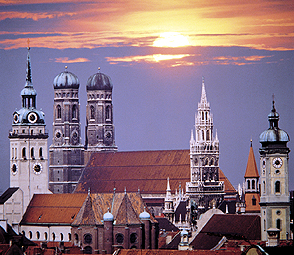
The Whole Story
This is Part Two of a two-part article on Southern Germany. We invite you to read part one of the article, which was published in the Summer 2007 Issue of Canadian World Traveller.
If you plan to visit Southern Germany:
German National Tourist Office
Tel.: 1-877-315-6237
Email: info@gnto.ca
Websites: www.germany-tourism.de
and www.cometogermany.com
Ulm
Town of Ulm
Website: www.tourismus.ulm.de
Munich
Munich Tourism Office
Website: www.muenchen.de
Arabella Sheraton Grand Hotel
Website: Arabella Sheraton Grand Hotel München
Nuremberg
City of Nuremberg
Website: www.tourismus.nuernberg.de
Arabella Sheraton Hotel Carlton
Website: Arabella Sheraton Hotel Carlton Nürnberg
Getting There:
Lufthansa Airlines
Website: www.lufthansa.com

